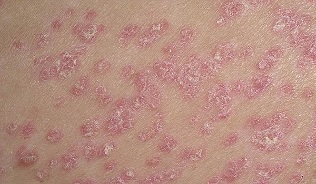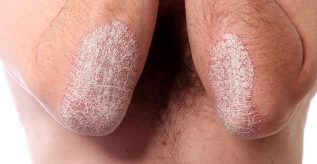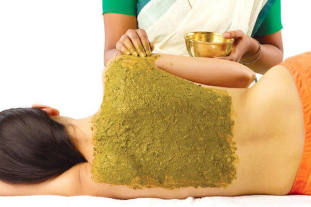When faced with psoriasis, many patients do not immediately recognize pathology, such as allergic rashes and other dermatitis. Timely diagnosis of the disease is important to know how is pathology, what are the steps of psoriasis and the symptoms of the disease at different stages. The course of psoriasis is characterized by four stages, among which are primary progressive, fixed stage and stage of regression. In more detail each of the steps we consider in this article.
Early stages of psoriasis

Many patients are interested in how psoriasis early stages? See the first manifestations of the disease can be a picture. This stage is characterized by the development of skin typical red, pink spots with clear boundaries. The disease can occur in different parts of the body. Here is a picture of the pathology of the different parts of the body.
Psoriasis symptoms in the early stages
In the early stage of the disease is characterized by the following symptoms:
- mild peeling of the dermis;
- redness of the skin;
- development itching;
- feeling, dryness, tightness;
- the formation of spots of different diameters;
- the gradual strengthening of the peeling.
The clinical picture of the disease can vary depending on the disease. So, psoriasis drops of the size of the tiles has a small diameter of not more than 2 — 3 mm. Common, vulgar, rashes remain high more than 5 cm, often merging together to form a large lake. For pustular psoriasis characterized by training the dermis crusts yellow or greyish with the accumulation of serous fluid under them.
The initial stage lasts for each patient in a different way. It depends on the immune system of the patient and other characteristics of the organism.
Treatment at an early stage
The first stage, the disease is often prescribed a topical treatment for lesions using creams, gels, lotions. Medicine the goal of treatment is to eliminate itching, flaking, swelling, redness, inflammation. To do this, use of hormonal and non-hormonal creams.
Hormones in the initial stage is prescribed rarely. Often their use is indicated in patients with an acute course of pathology.
Hormonal creams often cause side effects. It is recommended to use them only on prescription.
The progressive stage of psoriasis

A progressive stage characterized by increased symptoms of the disease, the plaques still itching, peeling, swelling, inflammation of the growth. A rash on the skin begin to blend together, affect large areas of the dermis. In progress-the stage of the frequent occurrence of this symptom is the phenomenon of kebne.. The essence of the phenomenon is the fact that new lesions appear in areas of injured skin. If the skin is scratches, abrasions, burns, in their place are likely to show plaques. The duration of the forward phase lasts an average of 14 days to several months. For each patient, this time depends on the individual characteristics of the organism and how quickly the immune system to cope with the disease.
Treatment far
Acute psoriasis requires a holistic approach using the following methods:
- Medication.
- The use of physical therapy.
- The fixation of the patient's way of life.
Important! Tactics of treatment is selected individually for each patient depending on the severity of the disease, peculiarities of its course and the presence of complications.
Medication
Getting rid of plaque and reduce the symptoms of medical use of the following drug groups:
- Antihistamines – the purpose is to reduce such symptoms, such as itching, redness.
- Sedative medications help remove excessive nervous tension and normalize sleep.
- Anti – inflammatory drugs - reliably relieves inflammation, helps eliminate redness and other signs of the disease.
- Diuretics are medications that are designed for the excretion of excess fluid and salt. These medicines help to cleanse the body, which positively affects the course of the disease.
- Keratolytic – to promote good exfoliation of the skin, strengthens regeneration of the dermis, to update it.
- Immunomodulators – control the functioning of the human immune system, which is an important part of the healing process.
- Hormonal creams give quick results, they are used mainly for serious illness.
- Cytotoxic agents – tend to suppress the immune system, which is sometimes necessary to get rid of psoriatic plaques.
All drugs should be used only after prescription. Self-treatment will only aggravate the disease.
Physiotherapy treatment
Methods of physical therapy are:
- PUVA-therapy;
- The use of ultra-sound irradiation.
- Magneto therapy.
- A range of treatment.
- The Laser beams.
- Mud.
- Paraffin baths.
- Spa-treatment.
The number of sessions and their duration, choice of doctor, taking into account the characteristics and type of disease, as well as the personal qualities and General well-being of the patient.
Traditional methods

Folk medicine methods is recommended:
- Natural oils (juniper or lavender). Has a healing and calming effect, a beneficial effect on the skin. Method of application: a few drops of oil add the cream and dot to put on the rash.
- Hydrogen peroxide (3%). The point is applied and not washed off. Before you need to consult a dermatologist.
- 30 g of propolis mixed with 250 ml of vegetable oil (pre-boil). The prepared mixture should be applied to dissolve the Horny layer of the epidermis and restores skin elasticity.
- Beeswax. This product has a calming effect. Beeswax should be melted in a water bath, and then gently apply on the bark, covering the pimples.
- Med. The main waste product of bees has a positive effect on the human body psoriasis. It should be consumed in limited quantities – 2 tablespoons per day.
Tincture against psoriasis
Popular treatments uses all the same oil and hydrogen peroxide.
You can add the tincture on the basis of celandine. For its preparation you will need 3 tablespoons of this plant (dried or fresh) and salt water. In no case can not use alcohol because it can dry up the skin.
How to prepare a remedy:
- the components must be mixed together;
- leave for a couple hours.
Before applying the tincture to the skin, it is recommended to lubricate the birch tar (dot) to improve the curative effect.
In order for treatment to be effective, the patient should go on a diet, harmful food cause aggravation of the condition.
Diet for psoriasis

Patients with psoriasis, it is important to follow a proper diet. The diet quickly becomes clear the skin blood platelets, prevent complication of the disease.
Principles of clinical nutrition as follows:
- It is necessary to abandon sharp, salty, sour, fried food. These products only enhance the growth of plaques.
- Diet is impregnated with a large amount of vegetables and fruits.
- The main meals, it is better to choose cereals, soups, lean fish and meat.
- The table should not be food allergens. You have to give up eggs, nuts, chocolate, citrus fruits.
- Drinks with caffeine are also excluded.
- Prohibited alcohol, carbonated beverages.
- Dairy products should not contain fat. Preference should be given yogurt without any additives, kefir, yogurt.
It is recommended to eat small portions to avoid overeating. Diet is an important part of the treatment of the disease. Proper nutrition helps to saturate the body with vitamins, rid of the toxins.
The stationary phase
The stationary phase characterized by decline in the growth psoriatic plaques, and their number in the body is not impaired, the disease seemed to go into sleep mode. The presence of precipitating factors, pathology in place can again go to the stage progress. The reasons for this phenomenon becomes improper treatment, refusal to diet, trauma to the skin. The duration of the stationary phase are so different in different patients, which is quite difficult even to imagine. On average, it takes several weeks to several years.
Stage regression
Stage regression is the final step before remission of the disease. Here are the following changes:
- Color pimples bright red passing to pale, pink hue.
- Decreases the amount of peeling.
- Goes itching.
- The skin is cleansed, becomes smoother tone and texture.
- Although some parts of the body are the so-called "on-duty plaques". Such eruptions are not completely retained on the skin even during remission.
Psoriasis refers to a chronic inflammation of the skin, non-infectious nature. To completely get rid of the disease has so far been possible. Patients who have a pathology, you have a lifetime to adhere to preventive measures to prevent recurrence. Many patients are able to maintain forgiveness for many years, and live a full life.
























